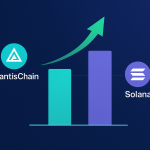NFT & Blockchain
NFT Market Crashes: 95% Of Assets Become Worthless

Introduction
The world of non-fungible tokens (NFTs) has experienced a meteoric rise, capturing the attention of artists, investors, and tech enthusiasts alike. However, this booming market has recently hit a severe downturn, with reports indicating that 95% of NFT assets have plummeted in value, rendering them essentially worthless. This dramatic shift has left many questioning the sustainability and future of NFTs as a viable digital asset class.
The Rise And Fall Of NFTs
NFTs first gained widespread popularity in early 2021, offering a novel way to own and trade digital art and collectibles on the blockchain. High-profile sales, such as Beeple’s “Everydays: The First 5000 Days,” which sold for $69 million at Christie’s, fueled a frenzy that saw celebrities, brands, and everyday investors flocking to the market. The allure of unique, verifiable ownership combined with the potential for substantial returns created a gold rush mentality.
However, as with many speculative bubbles, the rapid expansion of the NFT market was unsustainable. By late 2023, signs of trouble began to emerge. Market analysts pointed to several factors contributing to the current crash.
Factors Behind The Crash
Market Saturation: The initial novelty of NFTs led to a flood of new projects and assets, saturating the market. Many of these projects lacked originality or intrinsic value, leading to a decline in overall quality and buyer interest.
Speculative Behavior: Much of the NFT market’s growth was driven by speculative investments, with buyers hoping to flip assets for quick profits. This speculation created a volatile environment where prices were inflated beyond sustainable levels.
Economic Downturn: Broader economic conditions also played a role. With rising inflation and economic uncertainty, investors began to pull back from riskier assets, including NFTs. This shift in investment behavior contributed to the rapid devaluation of digital assets.
Regulatory Concerns: Increasing scrutiny from regulatory bodies worldwide added another layer of uncertainty. Concerns about money laundering, tax evasion, and lack of consumer protection prompted calls for tighter regulation, which further dampened investor confidence.
Impact On Artists And Collectors
The crash has had profound implications for artists and collectors alike. Many artists who initially embraced NFTs as a new revenue stream now face significant financial losses. The devaluation of their work has also led to a loss of credibility and trust in the digital art community.
Collectors, particularly those who invested significant sums in high-profile NFTs, have seen their investments evaporate almost overnight. The psychological and financial impact of these losses cannot be understated, leading to widespread disillusionment with the NFT space.
The Future Of NFTs
Despite the current turmoil, many experts believe that NFTs are not entirely doomed. Instead, they argue that the market is undergoing a necessary correction, weeding out unsustainable projects and speculative behavior. This reset could pave the way for a more stable and mature NFT ecosystem.
Innovation and Utility: For NFTs to regain their footing, innovation and utility will be key. Projects that offer real value and unique applications, such as gaming, virtual real estate, and intellectual property rights, are more likely to thrive in the long run.
Stronger Regulations: Clearer regulatory frameworks could help legitimize the NFT market and protect investors. By addressing concerns related to fraud, money laundering, and consumer protection, regulations could foster a more trustworthy and transparent marketplace.
Community and Education: Building a robust community and educating both creators and buyers about the potential and pitfalls of NFTs will be crucial. This includes promoting best practices for creating, buying, and selling NFTs, as well as highlighting successful case studies and innovative use cases.
Conclusion
The NFT market crash serves as a stark reminder of the volatility and risks inherent in emerging technologies and speculative investments. While the future of NFTs remains uncertain, there is potential for recovery and growth if the market can evolve beyond its speculative roots. By focusing on innovation, utility, and regulatory clarity, the NFT space can rebuild trust and establish itself as a legitimate and valuable digital asset class.










